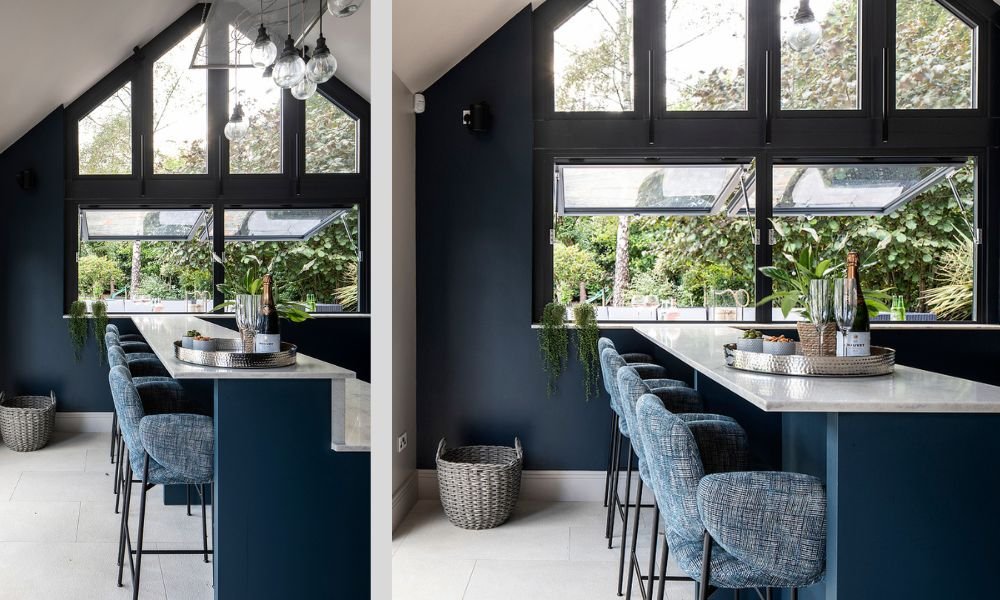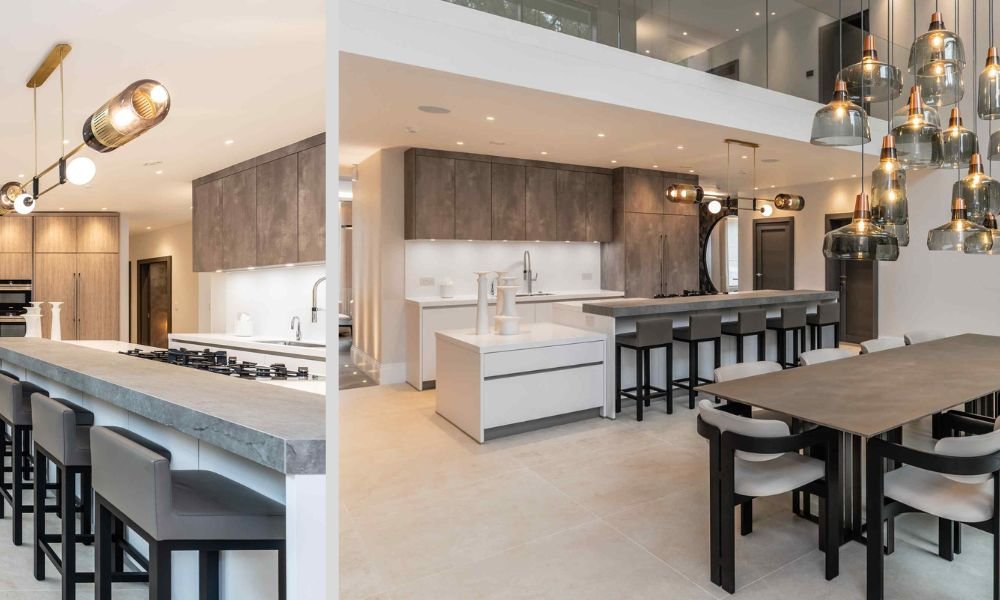What is a kitchen island? A kitchen island is a distinct, freestanding structure that is usually designed in the middle of the kitchen and its purpose can either be aesthetic, functional or both.
Some kitchen islands can have seating around them, in-built storage units or even appliances installed in them. So they’re quite multi-functional, but the question is, do you need a kitchen Island in your kitchen?
We believe that the answer to this can only be established after looking at the benefits and drawbacks of having one:
What are the Pros and Cons of having a Kitchen Island?
PROS
- They maximise your space: as they can be accessed from all four sides, they offer you plenty of room, especially as compared to traditional kitchen countertops. A well-designed kitchen island can also provide you with considerable storage space. You also get a lot of extra space in the kitchen to use the island as a countertop for preparing meals or multi-tasking in general.
- They enhance your kitchen: you can find kitchen islands in hundreds of different designs, styles and materials. Since they’re mostly located in the centre of the kitchen, they naturally become the focal point and this really upgrades the look of the kitchen. Any potential home buyers will also be impressed by a kitchen island, adding to your home’s resale value.
- You get an opportunity to add extra seating: if you don’t have a dining table in your kitchen, and even if you do – kitchen islands allow you to add extra seating so you, your family and friends can eat, drink or just socialise. Based on the height of the island, you have the option of using dining chairs or bar stools.
- They are multifunctional: Unlike traditional dining tables, modern kitchen islands can be made multi-functional by adding appliances to them, including ovens, dishwashers and sinks. It can also serve as a breakfast bar or work area.
CONS
- Can incur additional costs: Adding a kitchen island can cost you anywhere between $3000 to $20,000, depending on the materials and additional appliances that you go for.
- They can be tricky to design: Kitchen islands need to be perfectly placed, so they do not affect the flow of traffic in the kitchen.
Especially for smaller kitchens, while it’s possible to add an island, it needs to be designed by keeping all measurements in consideration.
You will also have to consider how the plumbing, electricity and vent will be connected to the island, especially if you’re planning on adding appliances.
The good and bad elements of having a kitchen island are both evident from the points shared above, and we’re hopeful that they will help you decide if investing in a kitchen island is worth it or not for you.
In our opinion, the major benefit of introducing an island is the multi-functionality it offers.
You get extra space for meal prep, you get to include additional seating or entertaining space and you develop a pleasant spot for your kids to interact with you or complete their schoolwork.
So the next topic we will move on to is: how to design kitchen islands.
Tips on Designing Kitchen Islands
So if you feel that having a kitchen island is the right choice for you, read on for some amazing design tips from our award-winning interior designers:
Meet the Experts:

ARCHITECT & INTERIOR DESIGNER

SENIOR INTERIOR DESIGNER

SENIOR INTERIOR DESIGNER
1 – Deciding the Best Size for Your Kitchen Island
Islands have the potential to be the showstoppers of your kitchen but they also take up a substantial amount of floor space.
This is why designing a kitchen island can be challenging because the size and proportions have to be perfect in order for the island to work out and not create any hindrances.
According to Cristina, “Ideally, there should be a minimum of three feet around the sides of the island for free flow of movement and a minimum of forty inches on the side facing the kitchen counter. You also need to check that no cabinets or appliances get obstructed. The overall size of the island should be proportional to the size of your kitchen.”
2 – Consider Your Needs
Before you start designing your kitchen islands – specify what you need from your island.
- What is the main purpose of your island? Is it for eating, preparing meals, cooking, entertaining or just for aesthetic purposes?
- Do you need storage?
- Do you want to add any fixtures or appliances?
- Will you or your family be eating on the island? If so, how often would you be using it?
- Would you prefer sitting on bar stools or dining chairs? Because the height of the kitchen island depends on it.
- What colour, shape and materials do you want to go for?
3 – Don’t Underestimate the Power of Lighting for Kitchen Islands
“I feel like lighting in the kitchen, especially above the kitchen island is often underrated. I see clients ready to spend thousands of dollars on the kitchen shelving and the island itself but not focusing much on the lighting,'” says Cristina. “In my opinion, lighting is what truly allows the island to shine. I usually recommend a grand chandelier above the island, if the kitchen is big enough. And for smaller kitchens, I suggest hanging any odd number of pendant lights. It’s important to remember that the right lighting can totally transform even the most ordinary-looking kitchen islands.”
We see this concept work out beautifully for the kitchen space in Cristina’s Redington Road project – a minimalist but statement-making black and white kitchen where three pendant lights above the kitchen island are totally stealing the show.
The designers have added a curved breakfast bar to this island, along with fluted detailing on the panelling – giving it all a very elegant and inviting look.

We also observed a similar use of pendant lights in the kitchen from Cristina’s Telfords Yard project.
You’ll notice how in both these kitchens, the designers ensured an ample distance was kept between the island and the lighting as well as between the three lamps. This is important to ensure a sense of symmetry and harmony.
Moreover, the lighting design chosen for both spaces was understated but elegant for a timeless look.
Since this kitchen was in a very well-lit area with lots of windows, the designers added dimmer switches so the lighting can be adjusted as needed.

4 – If You’re Short on Space, Consider a Portable Island
If your kitchen is relatively smaller or if you’re tight on budget, then the best thing you can do is invest in a movable kitchen island.
Ben recently completed furnishing the gorgeous Coulins residence in partnership with Rina Vastu. For the semi-outdoor kitchen shown below, the designers wanted a sleek kitchen island as the space was not too big. After careful consideration, they decided to go with a portable island as it offered enough space for meal assembly and as an eating space, along with providing two open storage shelves underneath it.
The island can easily be rolled to the patio for outdoor meals and parties or even when cleaning the kitchen, thanks to the fixable wheels and lightweight structure.
According to Ben, “this was the perfect solution because we did not want to take up any valuable floor space from the kitchen. And also because this kitchen had so many amazing elements, like the big green oven and the beautiful shelving, so we wanted them to have the limelight instead of creating distraction with a bulky island.”

5 – Play Around with the Materials
You’ll notice that for almost all the islands we’ve shared, our designers have chosen to use different materials instead of a single one.
“Working with two or more materials for the island really helps break up the structure, adding visual interest and this also makes it easier to style the kitchen. Because you’re no longer limited to a single colour, but you’re free to mix and match different materials in other elements too, such as the seating or the decor,” explains Ben.

6 – Varying the Height of the Island
“If you want to use bar stools with your kitchen island, then adding a heightened countertop to your island is not just a practical decision, but it really helps add visual interest,” explains Ricardo.

7 – Bring in Some Colour
“If you want to add colour to your island – I recommend going for something timeless instead of something trendy. Any colour that you feel will not feel like an eyesore after a few years,” says Cristina.
Ben adds, “Blue and White, for example, is a very interesting colour combination that works well for contemporary kitchens. It would also be a good idea to add your chosen colour around the house or at least in the room next to the kitchen, which is usually the living room, as this creates a harmonic transition.”
Here’s a look at the stunning Blue and White kitchen island from Ben’s Coulins project:

8 – Don’t Compromise on Quality
Remember that you do not usually get to rebuild or renovate your kitchen island, so investing in good quality materials will pay off for many years.
Ricardo says: “Designers usually prefer working with a combination of different materials for kitchen islands. Varying the height of the countertop is another strategy which can give your island a designer look. But the most important thing is to work with high-end, luxury materials – and if it is not affordable for the whole island, then for at least some part of it.”
When asked about the most popular materials for kitchen islands these days, Ricardo added, “Recently, there has been a huge shift towards textured matte finishes in the kitchen – this can be with all types of materials such as wood and stone. But personally, I prefer adding contrast to such finishes with a basic colour such as white or black.”
Here’s an example from our team’s Valley Road project, featuring a grey and white kitchen:

Summing up
We sincerely hope you have enjoyed reading this post and learning about some of the fantastic ways a kitchen island can be a great, fashionable, and useful addition to your kitchen.
If you have any more questions about kitchen islands or if you would like to go over any of the topics discussed above in further detail, get in touch with our helpful team members today.
We would love to assist you in designing the kitchen of your dreams, complete with the perfectly built island, placed exactly where it should be.
Frequently Asked Questions
Should your kitchen island match your cabinets?
Most interior designers recommend matching at least some part of your island to your cabinets, so your island seems to be blended in with the kitchen instead of feeling like a forced element.
How to make your kitchen island look better?
The first thing you can do to improve the look of your kitchen island is to invest in good-quality materials. Whether you’re opting for wooden detailing or marble, high-end materials speak for themselves. Moreover, once you build your kitchen islands, you’re very less likely ever to rebuild them, so it’s best to go for a timeless design and good materials. Once the island is built, you should maintain its look by keeping it clean. You can also accessorise your kitchen island with vases, a tray, candles or table linen.
What should be included in a kitchen island?
The basic kitchen island just gives you space for preparing meals or enjoying them. Most islands also have some sort of storage units attached to them in the form of open shelves, drawers and cabinets. Other than that, you can have any appliance that you need to be installed on your island, such as a sink, dishwasher, kitchen hob, microwave, wine cabinet or even a mini refrigerator.
Can you design your own kitchen island?
This depends on your design skills and the type of kitchen island that you want. If you just want a basic kitchen island and you have some experience in designing or working with proportions, then you can build your own island. However, if you’re new to this or if you want a high-end kitchen island with storage units or appliances, then it would be best to take help from a professional designer. It’s important to remember that designing kitchen islands can be more complicated than other design tasks because of all the measurements and proportions that need to be taken into account.
Is having a kitchen island a good idea?
A kitchen island is a remarkable means to maximize area, as you can make it multiple-purpose and feasible by incorporating built-in appliances and savvy storage solutions. Incorporating cooking appliances into the island puts them at the hub of the activity – even better if there is room for bar-style seating, so you can socialize while the food is being prepared. The island can also be used as a workstation or for the kids to do their homework. You’ll find all homeowners with kitchen islands to be happy with their decision, as the islands offer great utility in everyday life as well as for special occasions.
Do I need a big kitchen for an island?
According to our interior designers, while kitchen islands look best in bigger kitchens – a well-designed island can be a practical and aesthetic addition to smaller kitchens too. It’s important for the size of the island to be adjusted based on the kitchen size. For smaller kitchens, go for lighter structures, such as a wrought iron base. It would also be best to opt for longer islands instead of wider ones and you can also consider designing a T-shaped island.
What are the best colours for kitchen islands this year?
Grey, white, black, blue and a combination of these colours continue to be the most popular ones for kitchen islands. There has also been an increased popularity of textured finishes for the island top and fluted detailing around the island.




